1994 CHEVROLET CAVALIER tire size
[x] Cancel search: tire sizePage 152 of 243
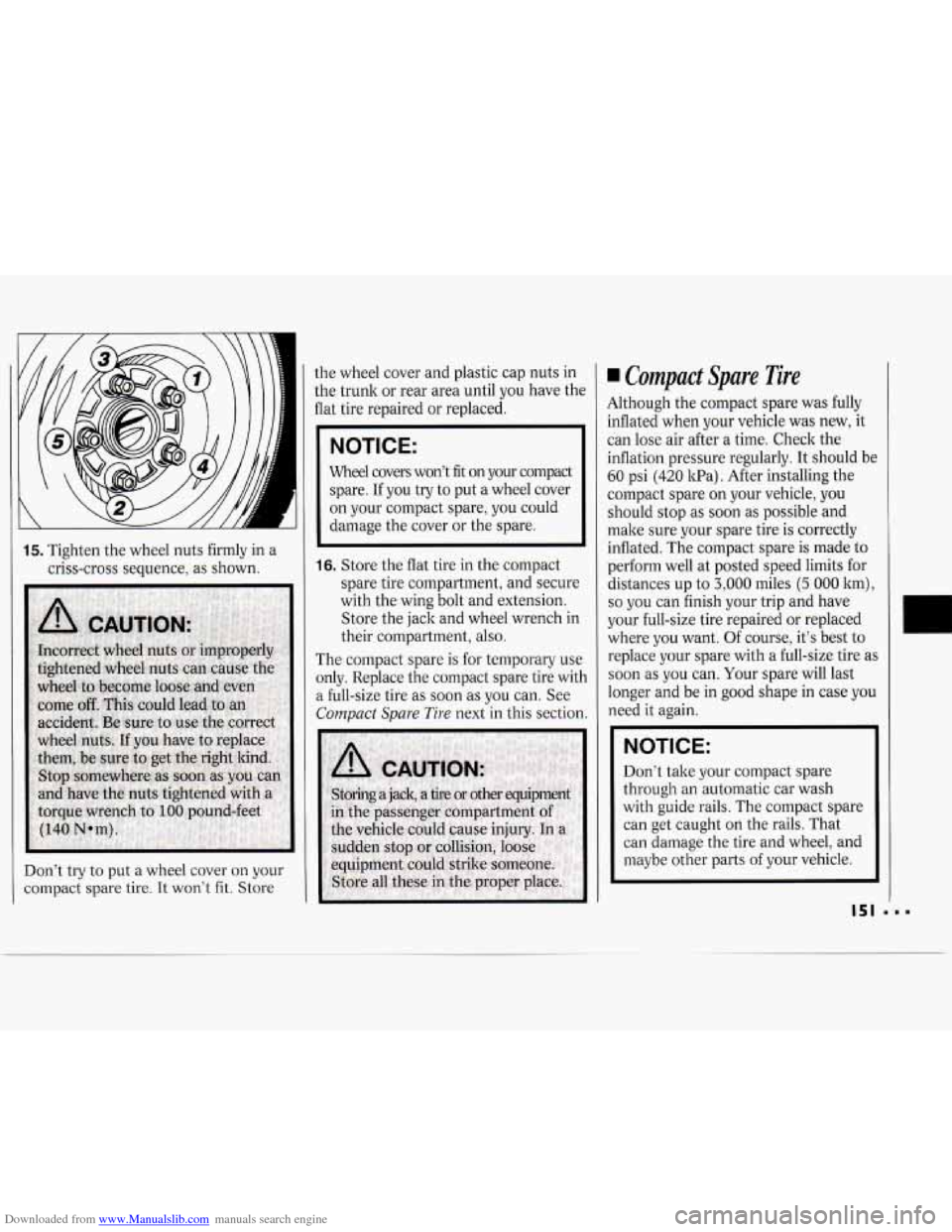
Downloaded from www.Manualslib.com manuals search engine 15. Tighten the wheel nuts firmly in a
criss-cross sequence, as shown.
Don’t try to put a wheel cover
on your
compact spare tire.
It won’t fit. Store the
wheel cover and plastic cap nuts in
the trunk or rear area until you have the
flat tire repaired or replaced.
IICE: I
Wheel covers won’t fit on your compact
spare. If you try to put a wheel cover
on your compact spare, you could
damage the cover or the spare.
16. Store the flat tire in the compact
spare tire compartment, and secure
with the wing bolt and extension.
Store the jack and wheel wrench in
their compartment, also.
The compact spare
is for temporary use
only. Replace the compact spare tire with
a full-size tire as soon as you can. See
Compact Spare Tire next in this section.
Compact Spare Tire
Although the compact spare was fully
inflated when your vehicle was new, it
can lose air after a time. Check the
inflation pressure regularly. It should be
60 psi (420 1cPa). After installing the
compact spare on your vehicle, you
should stop as soon as possible and
make sure your spare tire is correctly
inflated. The compact spare is made
to
perform well at posted speed limits for
distances up to
3,000 miles (5 000 lcm),
so you can finish your trip and have
your full-size tire repaired or replaced
where you want. Of course, it‘s best
to
replace your spare with a full-size tire as
soon as
you can. Your spare will last
longer and be in good shape in case you
need it again.
NOTICE:
Don’t take your compact spare
through an automatic car wash
with guide rails. The compact spare
can get caught on the rails. That
can damage the tire and wheel, and
maybe other parts
of your vehicle.
151
Page 181 of 243
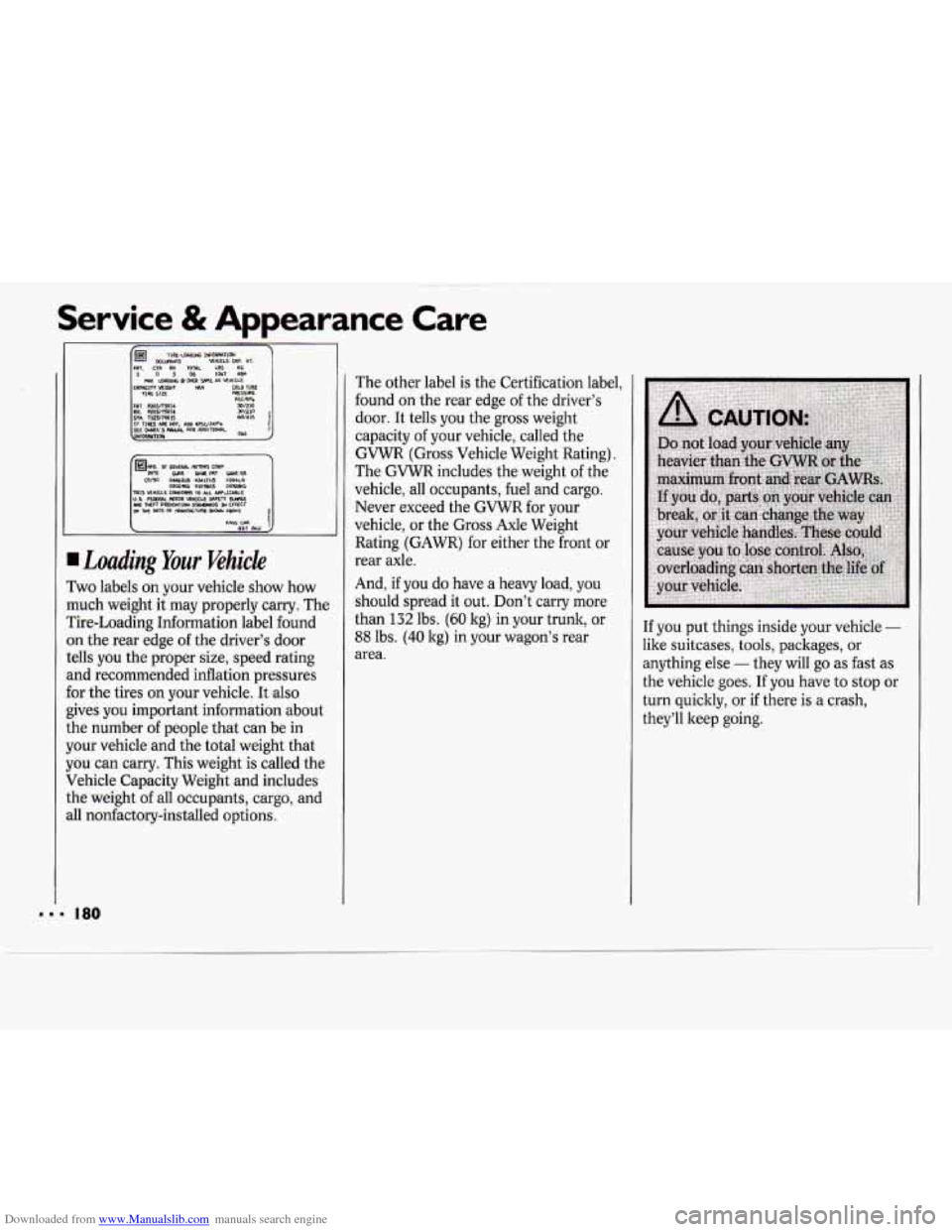
Downloaded from www.Manualslib.com manuals search engine Service & Appearance Care
I Loading Your Vehicle
Two labels on your vehicle show how
nuch weight it may properly carry. The
rire-Loading Information label found
In the rear edge of the driver's door
.ells you the proper size, speed rating
md recommended inflation pressures
or the tires on your vehicle. It also
:ives you important information about
.he number of people that can be in
four vehicle and the total weight that
rou can carry. This weight
is called the
Jehicle Capacity Weight and includes
.he weight
of all occupants, cargo, and
111 nonfactory-installed options. The other label is
the Certification label,
found on the rear edge of the driver's
door. It tells you the gross weight
capacity of your vehicle, called the
GVWR (Gross Vehicle Weight Rating).
The
GVWR includes the weight of the
vehicle, all occupants, fuel and cargo.
Never exceed the GVWR for your
vehicle,
or the Gross Axle Weight
Rating (GAWR) for either the front or
rear axle.
And, if you do have a heavy load, you
should spread it out. Don't carry more
than
132 lbs. (60 kg) in your trunk, or
88 lbs. (40 kg) in your wagon's rear
area. If you put things inside your vehicle -
like suitcases, tools, packages, or
anything else
- they will go as fast as
the vehicle goes. If you have to stop or
turn quicltly, or
if there is a crash,
they'll keep going.
Page 185 of 243
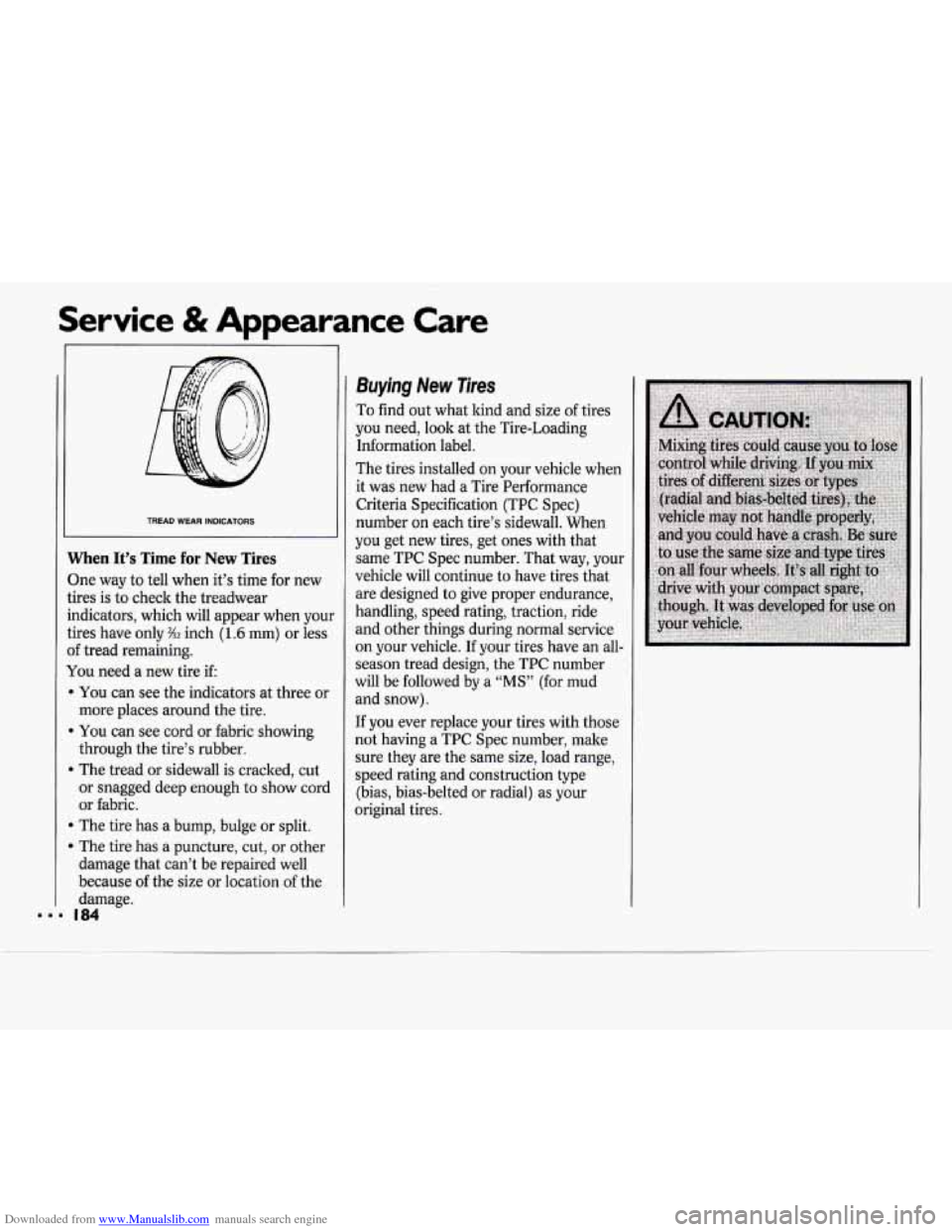
Downloaded from www.Manualslib.com manuals search engine Service & Appearance Care
TREAD WEAR INDICATORS
When It’s Time for New Tires
3ne way to tell when it’s time for new
;ires is to check the treadwear
ndicators, which will appear when your
;ires have only
%Z inch (1.6 mm) or less
If tread remaining.
llou need a new tire if:
m You can see the indicators at three or
m You can see cord or fabric showing
B The tread or sidewall is cracked, cut
more places
around the tire.
through the tire’s rubber.
or snagged deep enough
to show cord
or fabric.
B The tire has a bump, bulge or split.
The tire has a puncture, cut, or other
damage that can’t be repaired well
because of the size or location of the
damaEe.
Buying New Tires
To find out what kind and size of tires
you need,
look at the Tire-Loading
Information label.
The tires installed on your vehicle when
it was new had a Tire Performance
Criteria Specification (TPC Spec)
number on each tire’s sidewall. When
you get new tires, get ones with that
same TPC Spec number. That way, your
vehicle will continue to have tires that
are designed to give proper endurance,
handling, speed rating, traction, ride
and other things during normal service
on your vehicle. If your tires have an all-
season tread design, the TPC number
will be followed by a
“MS” (for mud
and snow).
If you ever replace your tires with those
not having a TPC Spec number, make
sure they are the same size, load range,
speed rating and construction type
(bias, bias-belted or radial) as your
original tires.
Page 188 of 243
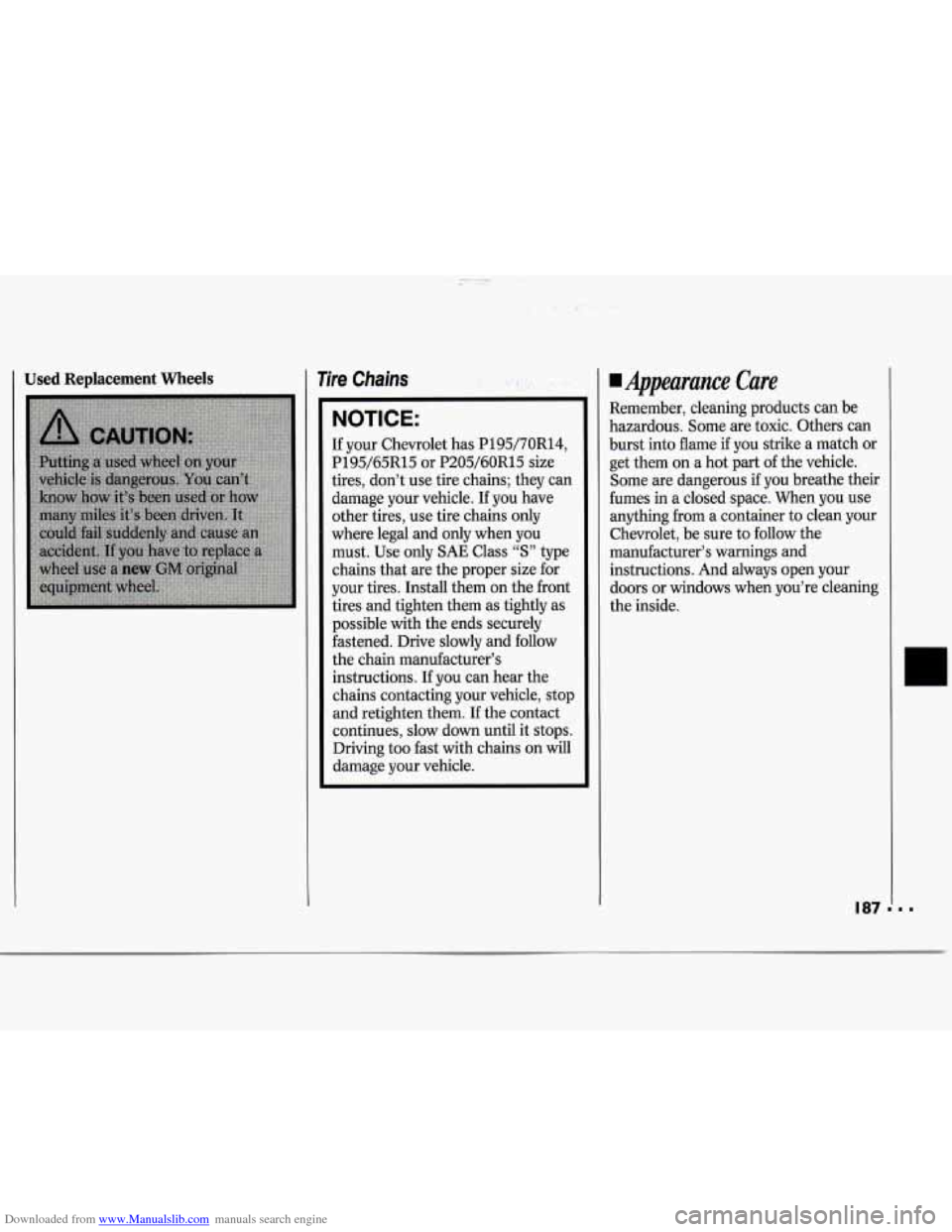
Downloaded from www.Manualslib.com manuals search engine I Used Replacement Wheels Tire Chains . ..
NOTICE:
If your Chevrolet has P195/70R14,
P195/65R15 or P205/60R15 size
tires, don’t use tire chains; they can
damage your vehicle. If you have
other tires, use tire chains only
where legal and only when you
must. Use only
SAE Class “S” type
chains that are the proper size for
your tires. Install them on the front
tires and tighten them as tightly as
possible with the ends securely
fastened. Drive slowly
and follow
the chain manufacturer’s
instructions. If you can hear the
chains contacting your vehicle, stop
and retighten them. If the contact
continues, slow down until it stops.
Driving too fast with chains on will
damage your vehicle.
Uppearance Care
Remember, cleaning products can be
hazardous. Some are toxic. Others can
burst into flame
if you strike a match or
get them on a hot part of the vehicle.
Some are dangerous
if you breathe their
fumes in a closed space. When you use
anything from a container to clean your
Chevrolet, be sure to follow the
manufacturer’s warnings and instructions. And always open your
doors or windows when you’re cleaning
the inside.
I87
Page 199 of 243
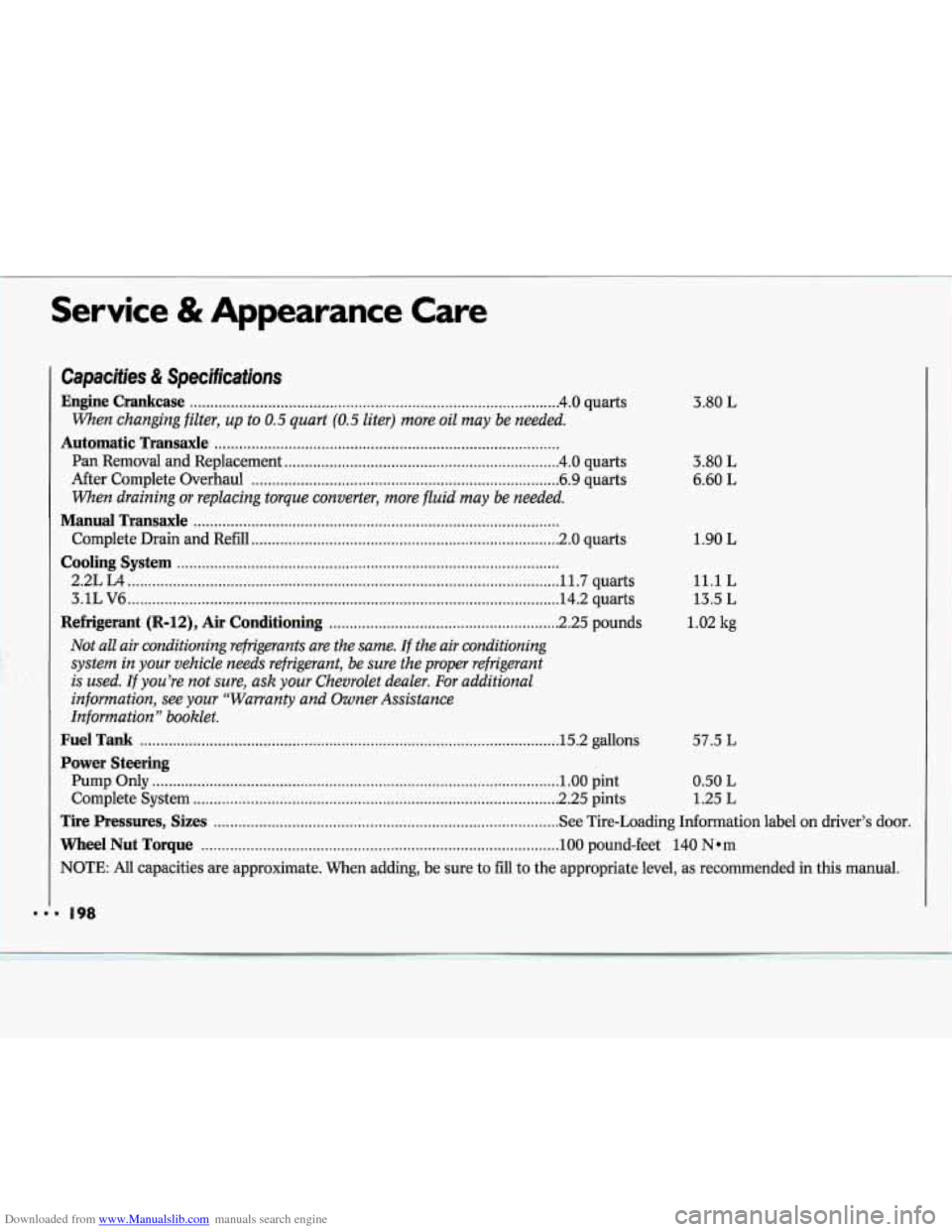
Downloaded from www.Manualslib.com manuals search engine Service & Appearance Care
Capacities & Specifications
Engine Crankcase ........................................................................\
.................. 4.0 quarts
When changing filter, up to 0.5 quart (0.5 liter) more oil may be needed.
Automatic Transaxle ........................................................................\
............
Pan Removal and Replacement ................................................................... 4.0 quarts
After Complete Overhaul
........................................................................\
... 6.9 quarts
When draining or replacing torque converter, more fluid may be needed.
Manual Transaxle ........................................................................\
.................
Complete Drain and Refill ........................................................................\
... 2.0 quarts
Cooling System ........................................................................\
.....................
2.2L L4 ........................................................................\
................................. 11.7 quarts
3.1L V6
........................................................................\
................................. 14.2 quarts
Refrigerant (R-12), Air Conditioning ........................................................ 2.25 pounds
Not all air conditioning refrigerants are the same. If the air conditioning
system in your vehicle needs refrigerant, be sure the proper refrigerant
is used. If you’re not sure, ask your Chevrolet dealer. For additional
information, see
your “Warranty and Owner Assistance
Information
” booklet.
Fuel Tank ........................................................................\
............................. .15.2 gallons
Power Steering
Pump Only ........................................................................\
........................... 1.00 pint
Complete System
........................................................................\
................. 2.25 pints 3.80
L
3.80
L
6.60 L
1.90
L
11.1 L
13.5 L
1.02 kg
57.5 L
0.50 L
1.25 L
Tire Pressures, Sizes ........................................................................\
............ See Tire-Loading Information label on driver’s door.
Wheel Nut Torque ........................................................................\
............... 100 pound-feet 140 Nom
NOTE: All capacities are approximate. When adding, be sure to fill to the appropriate level, as recommended in this manual.